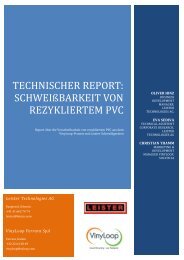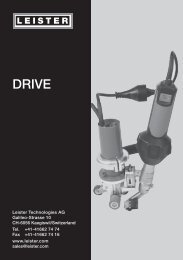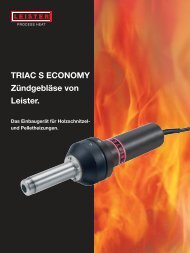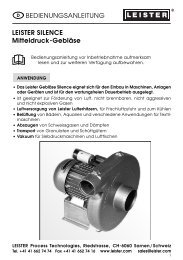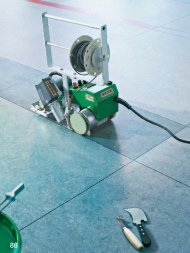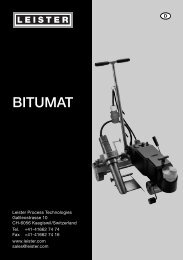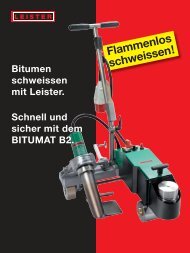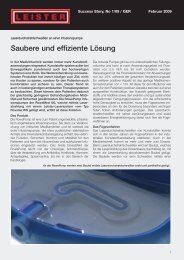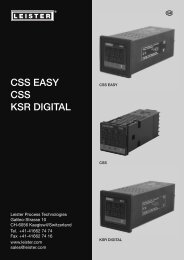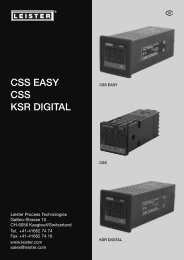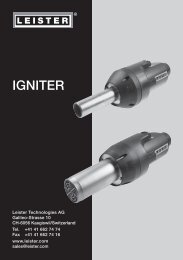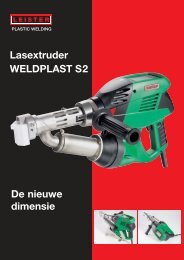Better hearing thanks to laser welding - Leister
Better hearing thanks to laser welding - Leister
Better hearing thanks to laser welding - Leister
You also want an ePaper? Increase the reach of your titles
YUMPU automatically turns print PDFs into web optimized ePapers that Google loves.
The development of <strong>hearing</strong> aids has been facilitated<br />
by the incorporation of <strong>laser</strong> <strong>welding</strong> using the mask<br />
<strong>welding</strong> concept. It is necessary <strong>to</strong> provide protection<br />
in the area of the sound outlet in order <strong>to</strong> guarantee<br />
reliable functioning of <strong>hearing</strong> aids that are getting<br />
ever smaller and which are worn within the ear. In the<br />
novel «SmartGuard» cerumen protection concept by<br />
Phonak, a highly elastic, extremely thin diaphragm is<br />
welded on<strong>to</strong> a small carrier ring. The mask <strong>welding</strong><br />
process, developed and patented by <strong>Leister</strong> Process<br />
Technologies, enables this high-precision joining<br />
process.<br />
Protection from contamination<br />
Hardness of <strong>hearing</strong> and reduced <strong>hearing</strong> capability is<br />
widespread. In many cases these conditions can be relieved<br />
<strong>to</strong> a large degree by the use of modern <strong>hearing</strong> aids.<br />
Success S<strong>to</strong>ry, No 2/08 / ENG March 2007<br />
Laser <strong>welding</strong> of cerumen protec<strong>to</strong>rs on Phonak <strong>hearing</strong> aids<br />
<strong>Better</strong> <strong>hearing</strong> <strong>thanks</strong> <strong>to</strong> <strong>laser</strong> <strong>welding</strong><br />
A typical ITE <strong>hearing</strong> aid is nowadays only as big as the tip of<br />
your little finger.<br />
Continuous development of <strong>hearing</strong> aids also leads <strong>to</strong><br />
miniaturisation, with the aim of providing the user with<br />
smaller, more comfortable and virtually invisible <strong>hearing</strong><br />
aids. There are different types of <strong>hearing</strong> aids which differ<br />
in their shape: so-called BTE (behind the ear) <strong>hearing</strong> aids<br />
and the considerably smaller ITE (in the ear) <strong>hearing</strong> aids.<br />
In addition <strong>to</strong> the technical differences, the ITE <strong>hearing</strong><br />
aids primarily have the optical advantage that, depending<br />
upon the shape, they are virtually invisible from the outside.<br />
A big problem with all <strong>hearing</strong> aids is the contamination<br />
of the sound outlet by ear wax in the audi<strong>to</strong>ry channel, the<br />
so-called cerumen. The loudspeaker – also called the earpiece<br />
– is located deep within the ear channel, particularly<br />
in the case of the ITE <strong>hearing</strong> aids. In order <strong>to</strong> ensure longterm<br />
functioning this must be effectively protected from<br />
contamination and moisture. The demands on such protection<br />
are high: In addition <strong>to</strong> the acoustic properties,<br />
strength, durability and media resistance as well as consistent<br />
high quality play a significant role.<br />
The Swiss <strong>hearing</strong> aid specialist Phonak has a turnover<br />
of more than a billion Swiss Francs and a global market<br />
share of 16 <strong>to</strong> 17 % and is thus one of the leading <strong>hearing</strong><br />
aid manufacturers in the world. Phonak is constantly making<br />
new innovations that make a considerable contribution <strong>to</strong><br />
The diaphragm is welded upon the cerumen protection on a<br />
<strong>Leister</strong> WS (work station).<br />
1
the improvement in quality of life of people with <strong>hearing</strong><br />
damage. One of these innovations is the new cerumen<br />
protec<strong>to</strong>r «SmartGuard». This uses a 15 µm thick polymer<br />
diaphragm <strong>to</strong> protect the sound outlet from cerumen and<br />
moisture, without having any significant deleterious effect<br />
on the acoustic properties. The diaphragm is mounted on<br />
a thermoplastic carrier ring. The strength of the connection<br />
<strong>to</strong> the carrier ring is high, despite the small area of the<br />
joint. Any deposits on the diaphragm can be removed by<br />
regular wiping with a soft cloth. This does not damage the<br />
diaphragm or the connection <strong>to</strong> the carrier ring, thus<br />
ensuring a long working life for the cerumen protec<strong>to</strong>r.<br />
The «SmartGuard» protection system with the 15 µm thick<br />
diaphragm is bonded <strong>to</strong> the carrier ring using <strong>laser</strong> <strong>welding</strong>.<br />
Laser <strong>welding</strong> also means that the necessary media<br />
resistance of the joint is achieved. The recommended<br />
period of use of two months exceeds the period of use of<br />
the existing fabric based protection systems. After this<br />
period of use, the cerumen protection can easily be<br />
replaced using a special <strong>to</strong>ol.<br />
Mask <strong>welding</strong><br />
The mask <strong>welding</strong> process – developed and patented by<br />
the Swiss <strong>laser</strong> system manufacturer <strong>Leister</strong> Process Tech-<br />
2<br />
nologies and operating on the principle of <strong>laser</strong> transmission<br />
<strong>welding</strong> – is used for joining the diaphragm <strong>to</strong> the carrier<br />
ring. This involves connecting a joining partner that is transparent<br />
<strong>to</strong> <strong>laser</strong> radiation with an absorbing joining partner.<br />
In the case of the cerumen protection, the diaphragm is<br />
transparent <strong>to</strong> <strong>laser</strong> radiation. The carrier ring, on the other<br />
hand, is made from a thermoplast material which has a<br />
fixed shape. It is black in colour and thus absorbs the <strong>laser</strong><br />
radiation. In the mask <strong>welding</strong> process used here, a mask<br />
is inserted between the <strong>laser</strong> source (diode <strong>laser</strong>) and the<br />
component. A linear, well collimated – in other words, parallel<br />
– <strong>laser</strong> beam is moved over the parts <strong>to</strong> be joined.<br />
The <strong>laser</strong> radiation only impinges on the parts <strong>to</strong> be joined<br />
that are not blocked off by the mask. The use of the mask<br />
makes it possible <strong>to</strong> illustrate the finest of structures. This<br />
means that mask <strong>welding</strong> can achieve high levels of precision.<br />
The principle of mask <strong>welding</strong>. The surfaces located in the<br />
shadow of the mask are not irradiated.<br />
This <strong>welding</strong> concept allows fulfilling a further requirement,<br />
namely the need <strong>to</strong> keep the area for <strong>welding</strong> <strong>to</strong> a minimum.<br />
This means that there is more area available for the<br />
acoustically active diaphragm surface. It is only with the<br />
mask <strong>welding</strong> process that the necessary strength can be<br />
achieved with the smallest of <strong>welding</strong> areas. A further significant<br />
advantage is the minimal weld pool depth. The<br />
formation of a weld bead can be virtually eliminated. This,<br />
in turn, has advantages with regard <strong>to</strong> dimensional reproducibility<br />
and acoustics.<br />
Phonak evaluated various joining processes for this<br />
demanding application. The requirements for <strong>welding</strong> consisted,<br />
in general, of the resistance <strong>to</strong> mechanical and<br />
chemical activity. Laser <strong>welding</strong> had the following advantages<br />
when compared with the other processes: No pretreatment<br />
of the surfaces, such as plasma irradiation or<br />
priming (chemical activation of the surfaces) is required.<br />
These would have a negative effect on the foil. Joining<br />
processes which produce melting would not be acceptable<br />
because of space restrictions.<br />
The high level of reproducibility associated with mask<br />
<strong>welding</strong> has proven <strong>to</strong> be an advantage over joining processes<br />
involving the application of additional materials.
In addition <strong>to</strong> the process-technological reasons, mask<br />
<strong>welding</strong> also has economical advantages. The consumption<br />
of supplies is regarded <strong>to</strong> be low, when compared<br />
with other processes. Batch processing processes, which<br />
are carried out semi-au<strong>to</strong>matically and which can be run<br />
on plants such as the NOVOLAS WS allow volumes of<br />
several millions <strong>to</strong> be produced in a year. Not least is the<br />
advantage that the joining process is even more economical<br />
because of the lack of additional material consumption.<br />
Cus<strong>to</strong>mer: Phonak Hörgeräte, Stäfa, Schweiz<br />
Authors:<br />
Oliver Hinz, Produktmanager Lasersystems<br />
Jürg Nötzli, Salesmanager Lasersystems<br />
Success S<strong>to</strong>ry, No 2/08 / ENG<br />
Prospects<br />
Because of the properties already referred <strong>to</strong>, the mask<br />
<strong>welding</strong> process is particularly suited <strong>to</strong> applications in<br />
medical technology. In this way foils can be welded on<strong>to</strong><br />
micro well plates without the melt flowing in<strong>to</strong> the apertures.<br />
Mask <strong>welding</strong> is also recommended for fluidics in<br />
general – and for micro fluidic components in particular.<br />
This precise and cost-effective process finds applications<br />
in products for the entertainment electronics and computer<br />
peripherals.<br />
Another process developed by <strong>Leister</strong> is radial <strong>welding</strong>.<br />
In this process, rotationally-symmetrical parts are<br />
welded <strong>to</strong>gether without having <strong>to</strong> move with respect <strong>to</strong><br />
the <strong>laser</strong>. In medical technology this process is used for<br />
<strong>welding</strong> catheter attachments. Radial <strong>welding</strong> also finds<br />
applications in sensor technology, fluidics and in the au<strong>to</strong>motive<br />
engineering.<br />
The GLOBO <strong>welding</strong> process, patented by <strong>Leister</strong>,<br />
also finds applications in medical technology. It allows<br />
dynamic pressing <strong>to</strong>gether of the joining parts, and, for<br />
example, it allows two transparent foils <strong>to</strong> be welded<br />
<strong>to</strong>gether. The heat energy is transferred <strong>to</strong> the foils by an<br />
absorbent black substrate [which has a melting point which<br />
is higher than that of the parts <strong>to</strong> be joined <strong>to</strong>gether]. This<br />
concept can be used <strong>to</strong> join large area components and<br />
endless applications.<br />
Turn-key <strong>laser</strong> machine NOVOLAS WS<br />
for <strong>welding</strong> plastics.<br />
3
<strong>Leister</strong> Technologies LLC<br />
Itasca, IL, USA<br />
Our close worldwide network of more than 120 Sales and Service Centres in more than 60 countries.<br />
4<br />
®<br />
Headquarters:<br />
<strong>Leister</strong> Process Technologies<br />
Galileostrasse 10<br />
6056 Kaegiswil/Switzerland<br />
<strong>Leister</strong> Process Technologies is an ISO 9001:2000 certified company.<br />
<strong>Leister</strong> Technologies GmbH<br />
Aachen, Germany<br />
phone: +41 41 662 74 74<br />
fax: +41 41 662 74 16<br />
leister@leister.com<br />
<strong>Leister</strong> Process Technologies<br />
Headquarters and Manufacturing<br />
Sarnen, Switzerland<br />
www.leister.com<br />
<strong>Leister</strong> Technologies Ltd.<br />
Shanghai, China<br />
© Copyright by <strong>Leister</strong><br />
Success S<strong>to</strong>ry, No 2/08 / d März 2008



